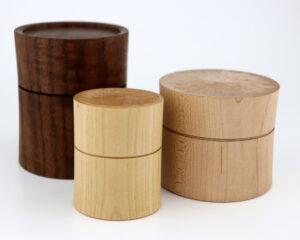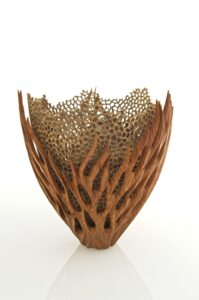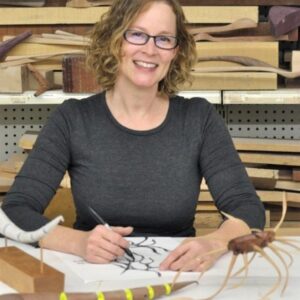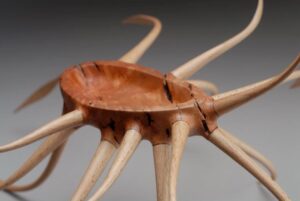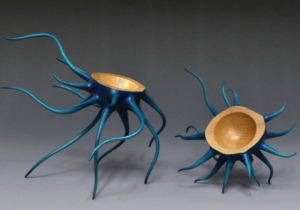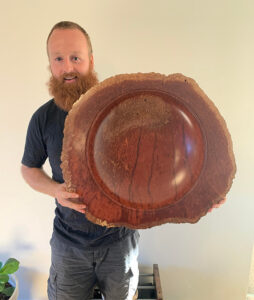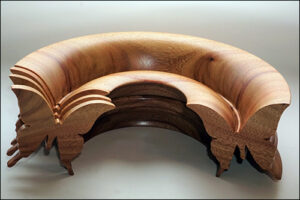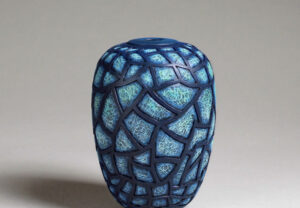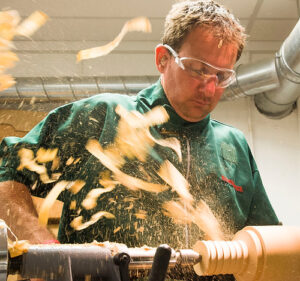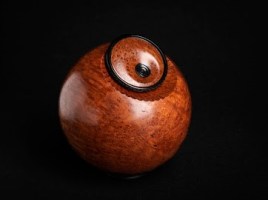| Eric Lofstrom |
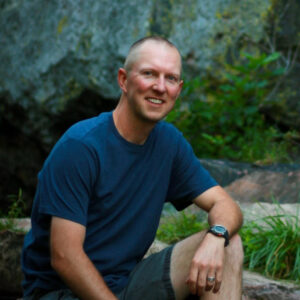 |
Creating thoughtfully distilled art to inspire presence, reflection, & connection. Empowering others through coaching & intentional, differentiated instruction.
|

|
Eric's Introduction to Woodturning...Eric’s earliest memories of creating with wood are in Grandpa's dirt floor, basement workshop; he had a special place at the bench, right next to the scrap bin. Eric grew up around woodworking, but had never learned about a tool called the lathe until the first weekend in October of 2001, while attending a free demo at a woodworking store in Sumner, WA. It was here that his woodworking trajectory changed and the woodturning adventures began. A demonstration on turning pens and letter openers was all it took to hook his curiosity. Creating shavings on a lathe consumed Eric’s thoughts for the next few weeks as he wrapped his brain around how a finished piece could emerge from rough materials so quickly! After hearing all the details (several times), Eric’s wife pursued this spark of excitement and set his woodturning journey in motion with a mini lathe and tool set for Christmas. Years later, Eric’s woodturning enthusiasm continues to grow. Like many turners, Eric began with scraps of 2x4s and “factory sharpened” tools. Several startling catches in the first few projects quickly focused him on the why and how of creating curls instead of settling for sawdust. Gaining tool control and improving technique became a personal quest. Whether creating a fitted lid box or multi-axis turning, a translucent or winged bowl, a hollow form or exploring surface embellishments, Eric enjoys projects which both challenge his skill and stretch his creative curiosity. In the fall of 2002, Eric began a membership with the South Puget Sound Chapter of the AAW. He enjoyed serving on the board of directors from 2005-2012 and representing the club at several woodworking shows in addition to mentoring others at the club's monthly sawdust sessions. He began demonstrating and teaching woodturning classes at local woodworking stores in 2006. Since then, Eric has taught at multiple symposiums and has become a highly sought-after instructor for woodturning clubs across the United States and Canada. The constant exposure to other turners continues to transform his awareness and understanding of turning fundamentals. Conscious of the importance tool control plays in creating pieces, Eric believes it is not only important to know which techniques work but also why they work. As a passionate teacher and woodturner, Eric is on a mission to impact the world of woodturning by helping others build confidence in tool control and developing their own creative voice! There is nothing more powerful than being inspired by an idea and having the courage and confidence to create that one-of-a-kind piece… to Eric, this is what woodturning is all about! |
| Neil Turner |
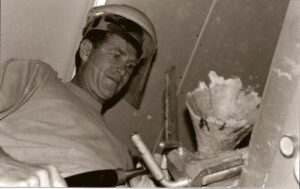 |
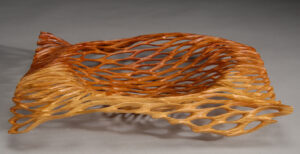
|
Wind, fire and waterThe Turner family farmed crops and sheep in the Wheatbelt region of Western Australia, just like generations of Turners before them. Working the land was tough: sparse rainfall, soil erosion, wind and fire. Neil found refuge is his woodturning workshop. Here he explored these same elements: wind, fire and water. He looked for the quiet ripples eroded in soil by wind, the delicate eddies left by water, and the swirling lick of flames. In the early days of his art practice he used refuse timber from the farm; roots and stumps uncovered from freshly tilled earth. He gradually built his skill. He was inspired by notable woodturners, like Stephen Hughes, to push the craft beyond the utilitarian towards something much more expressive. A coastal changeAfter fifty years on the farm, Neil and his family moved to the coastal region of Southwestern Australia. Here Neil observed the delicate corals and sponges dotted along the beaches and began to explore further the concept of transparency, creating delicately perforated pieces. Respecting the materialWoven through all of Neil Turner’s artwork is a deep respect for the material and the natural forces that have acted upon it. A powerful example of this is Neil’s fire form sculptures where he explores the dancing, ever changing patterns of flame. He works in negative, observing the subtle interplay of light and shadow and creating fluid forms from this very solid material. He primarily uses Australian timbers and works in a highly sympathetic way with the material, the natural features of the timber informing the finished piece. Neil’s work has been shown in galleries across Australia and internationally. His fine sculptures and furniture feature in both public and private collections and he has received public art commissions. He has also been invited to demonstrate his skills at numerous schools and associations both locally and internationally. Neil lives with his wife Suellen on ten acres of virgin bushland in the beautiful coastal region of Southwestern Australia. He and Suellen collaborate on a collection of modern and functional timber homewares, Turner + Turner. Neil is available for workshops and demonstrations as well as private commissions. You can contact the artist here.
|
I create minimalist contemporary sculpture inspired by my deep fascination with the natural world, and my mission as an artist is to tell a story through work at the intersection of art and science. I’m driven to make art that excites curiosity and connects us to the extraordinary, strange beauty of the world around us. The two decades I spent as a research molecular biologist allowed me to explore the complexity of our world, and I continue to view my surroundings through the eyes of a scientist. The structure of a leaf or the movement of a bacterium can be astonishingly beautiful, and I sculpt with the aim of illuminating the subtle and the tiny. Through my work I hope to deliver scientific content viscerally to encourage curiosity and a desire to look more closely at the smallest details of the fantastically rich and beautiful world around us.
|
Art in TimberWood turning and carving is so much more the traditional spindles and floral carvings to Simon. Instead, he has found beauty in the wood through refined form and texture. He specialising in bowls, carved embellishment and German ring turning. A lot of Simon's creative style has come from nature and then trial and error, trying to push his skill set to a new level as well as create unique works with a flare of his own. Despite Simon's age, he is an experienced turner who has been turning since 2010 and has made wood turning and carving his full time career since 2016. As a full time wood turner, Simon sells his works through galleries across NSW, takes on unique commission work, teaches classes and individuals and sells at local artisan markets. Simon's works are made in Australia from predominantly Australian salvaged timbers. Simon has had a passion for wood working since high school but even he didn't expect to have it become a full time career so early. With a background in cabinetmaking, a trip to Turnfest in 2016 motivated him to transform his hobby into a career. Starting from a humble 5 square meter shed in his back yard, he starting making pieces for galleries across NSW. Now Simon has a diverse range of avenues of work, not only selling his works through galleries and artisan markets, but also teaching and making unique custom pieces. He finds great enjoyment taking on the jobs that others seem to turn down, taking it as an opportunity to learn and challenge himself. When Simon isn't in the workshop, you will often find him in nature photographing Australian animals or playing squash. The interest for wildlife has been a part of his life since childhood but in more recent years, its become a true passion, especially snakes and other reptiles. Simon has found it really important to have a creative outlet away from the wood turning for a more balanced life. Check out some of his photos on instagram, Simon Begg's Animal Photography. |
Roberto Ferrer |
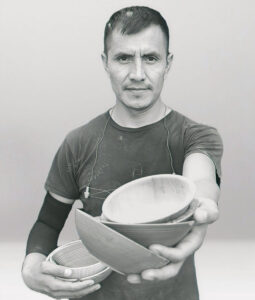 |
| A wood artist, a woodturner, a demonstrator, a teacher, a husband, a father...but most importantly I am a person who is passionate about art and wants to share this passion through my work. |
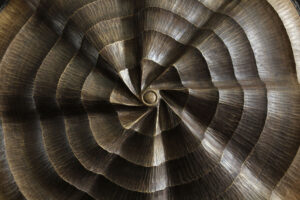
|
| When I think of this place, I don’t just think of a room full of wood and tools, I think of a place where I can spend hours thinking, listening to music, studying, analyzing past projects, admiring the wood’s grain that mother nature so carefully created for us to enjoy.
So, in a way, yes, it is a room full of tools and wood, dust, and shavings. The tables are full of different projects at different stages of completion. The walls are full of cabinets, and shelves with containers full of small parts, tools and supplies. And of course, there are machines that help me create my work. Some are small, some are big. Some of them I use very often, and some others stay unused for several months. During my early days of woodworking, I would run to the store and bring a handful of equipment, which I still use when needed. But as time went by I started acquiring some vintage machinery. I have loved antiques ever since I was a kid. What would a creative space be without sources of inspiration? Things and objects whose sole purpose is to adorn the walls and shelves, and to bring a smile to my face every time I look at them. So everywhere from the walls, shelves and rafters these objects hang and live in harmony with the noisy machines and dusty hand tools. And lastly, there are two windows that face different sides of the backyard. Through them, I can see my kids playing on the swing or can admire our garden during summer. During winter I can see the snow covering the trees and a small trail that we leave when we bring kitchen scraps to the compost pile. Every time I step into this space, I am grateful to have a place where I can work and set my mind free. It keeps me fresh during the summer and warm during the harsh Chicago winter. |
